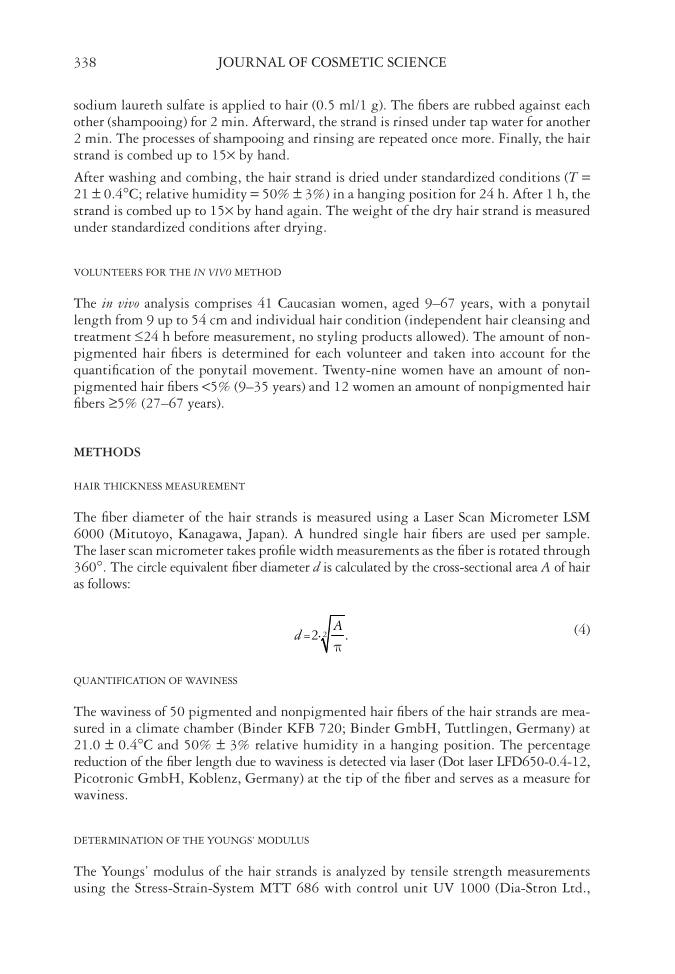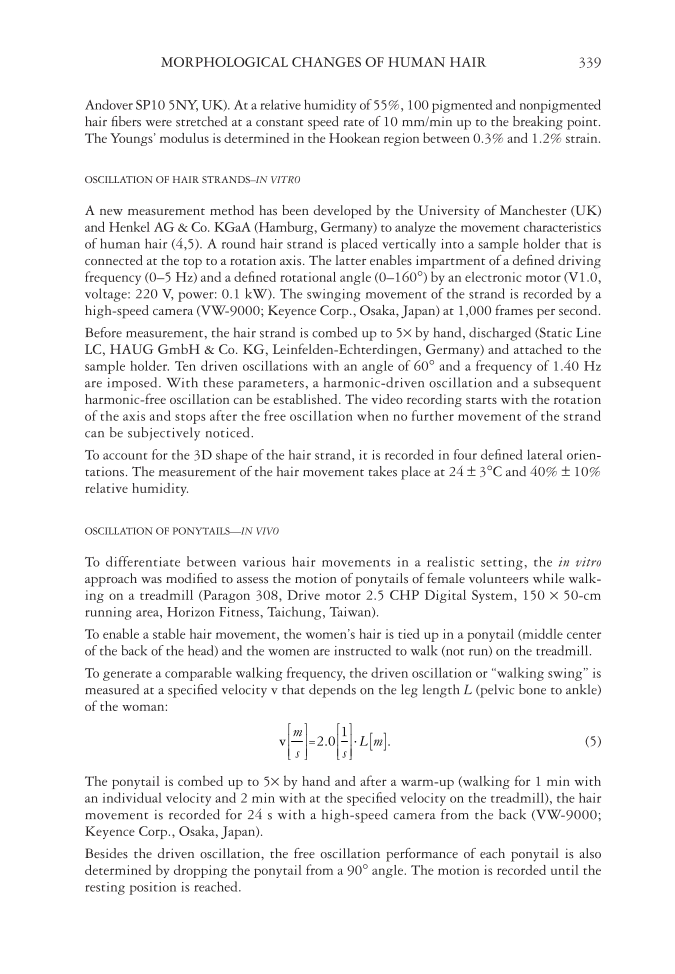JOURNAL OF COSMETIC SCIENCE 338 sodium laureth sulfate is applied to hair (0.5 ml/1 g). The fi bers are rubbed against each other (shampooing) for 2 min. Afterward, the strand is rinsed under tap water for another 2 min. The processes of shampooing and rinsing are repeated once more. Finally, the hair strand is combed up to 15× by hand. After washing and combing, the hair strand is dried under standardized conditions (T = 21 ± 0.4°C relative humidity = 50% ± 3%) in a hanging position for 24 h. After 1 h, the strand is combed up to 15× by hand again. The weight of the dry hair strand is measured under standardized conditions after drying. VOLUNTEERS FOR THE IN VIVO METHOD The in vivo analysis comprises 41 Caucasian women, aged 9–67 years, with a ponytail length from 9 up to 54 cm and individual hair condition (independent hair cleansing and treatment 24 h before measurement, no styling products allowed). The amount of non- pigmented hair fi bers is determined for each volunteer and taken into account for the quantifi cation of the ponytail movement. Twenty-nine women have an amount of non- pigmented hair fi bers 5% (9–35 years) and 12 women an amount of nonpigmented hair fi bers ≥5% (27–67 years). METHODS HAIR THICKNESS MEASUREMENT The fi ber diameter of the hair strands is measured using a Laser Scan Micrometer LSM 6000 (Mitutoyo, Kanagawa, Japan). A hundred single hair fi bers are used per sample. The laser scan micrometer takes profi le width measurements as the fi ber is rotated through 360°. The circle equivalent fi ber diameter d is calculated by the cross-sectional area A of hair as follows: 2 = 2· . Q A d (4) QUANTIFICATION OF WAVINESS T he waviness of 50 pigmented and nonpigmented hair fi bers of the hair strands are mea- sured in a climate chamber (Binder KFB 720 Binder GmbH, Tuttlingen, Germany) at 21.0 ± 0.4°C and 50% ± 3% relative humidity in a hanging position. The percentage reduction of the fi ber length due to waviness is detected via laser (Dot laser LFD650-0.4-12, Picotronic GmbH, Koblenz, Germany) at the tip of the fi ber and serves as a measure for waviness. DETERMINATION OF THE YOUNGS’ MODULUS The Youngs’ modulus of the hair strands is analyzed by tensile strength measurements using the Stress-Strain-System MTT 686 with control unit UV 1000 (Dia-Stron Ltd.,
MORPHOLOGICAL CHANGES OF HUMAN HAIR 339 Andover SP10 5NY, UK). At a relative humidity of 55%, 100 pigmented and nonpigmented hair fi bers were stretched at a constant speed rate of 10 mm/min up to the breaking point. The Youngs’ modulus is determined in the Hookean region between 0.3% and 1.2% strain. OSCILLATION OF HAIR STRANDS–IN VITRO A new measurement method has been developed by the University of Manchester (UK) and Henkel AG & Co. KGaA (Hamburg, Germany) to analyze the movement characteristics of human hair (4,5). A round hair strand is placed vertically into a sample holder that is connected at the top to a rotation axis. The latter enables impartment of a defi ned driving frequency (0–5 Hz) and a defi ned rotational angle (0–160°) by an electronic motor (V1.0, voltage: 220 V, power: 0.1 kW). The swinging movement of the strand is recorded by a high-speed camera (VW-9000 Keyence Corp., Osaka, Japan) at 1,000 frames per second. Before measurement, the hair strand is combed up to 5× by hand, discharged (Static Line LC, HAUG GmbH & Co. KG, Leinfelden-Echterdingen, Germany) and attached to the sample holder. Ten driven oscillations with an angle of 60° and a frequency of 1.40 Hz are imposed. With these parameters, a harmonic-driven oscillation and a subsequent harmonic-free oscillation can be established. The video recording starts with the rotation of the axis and stops after the free oscillation when no further movement of the strand can be subjectively noticed. To account for the 3D shape of the hair strand, it is recorded in four defi ned lateral orien- tations. The measurement of the hair movement takes place at 24 ± 3°C and 40% ± 10% relative humidity. OSCILLATION OF PONYTAILS—IN VIVO To differentiate between various hair movements in a realistic setting, the in vitro approach was modifi ed to assess the motion of ponytails of female volunteers while walk- ing on a treadmill (Paragon 308, Drive motor 2.5 CHP Digital System, 150 × 50-cm running area, Horizon Fitness, Taichung, Taiwan). To enable a stable hair movement, the women’s hair is tied up in a ponytail (middle center of the back of the head) and the women are instructed to walk (not run) on the treadmill. To generate a comparable walking frequency, the driven oscillation or “walking swing” is measured at a specifi ed velocity v that depends on the leg length L (pelvic bone to ankle) of the woman: ¯ ¡ ° ¡ ° ¡ ° ¡ ° 1¯ v =2.0 . m L m s s (5) The ponytail is combed up to 5× by hand and af ter a warm-up (walking for 1 min with an individual velocity and 2 min with at the specifi ed velocity on the treadmill), the hair movement is recorded for 24 s with a high-speed camera from the back (VW-9000 Keyence Corp., Osaka, Japan). Besides the driven oscillation, the free oscillation performance of each ponytail is also determined by dropping the ponytail from a 90° angle. The motion is recorded until the resting position is reached.
Purchased for the exclusive use of nofirst nolast (unknown) From: SCC Media Library & Resource Center (library.scconline.org)









































































































